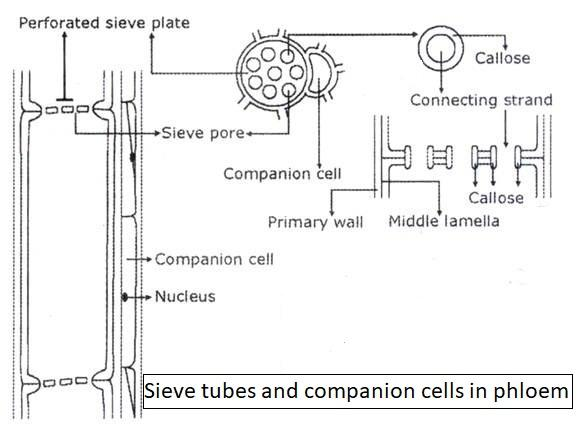
What are the different elements of phloem?
A. Xylem parenchyma, xylem fiber, vessels, companion cell
B. Vessels, companion cell, tracheids, xylem fiber
C. Sieve tubes, companion cells, phloem fibers, phloem parenchyma
D. Sieve tubes, companion cells, tracheids, vessels
Answer
485.1k+ views
Hint: Phloem is a vascular tissue that helps in the storage and transportation of molecules. Phloem is a major conducting tissue. The parenchyma derived elongated rectangular or cylindrical cells and some specialized parenchyma cells constitute the vascular structure of phloem.
Complete answer:
Phloem is heterogeneous vascular tissue that helps in the storage and transportation of products of photosynthesis that is good for the plant. It also adds in providing strength to the plant.
-It is one of the constituents of vascular bundles of plants that together make the conducting tissue system in plants. The other constituent of this system is xylem. It consists of xylem parenchyma, xylem fibers, tracheids, and vessels.

-Phloem parenchyma is parenchyma cells in association with phloem. They appear to be elongated cells rectangular or cylindrical. It stores fats and starch and in some plants, it forms periderm, a protective tissue.
-Companion cells are derived from the same parenchyma mother cells as in the case of sieve tubes. The companion cells aid in the functioning of sieve tubes. That’s why they are called companion cells. These are densely cytoplasmic nucleated cells that are the site for protein synthesis.
-Phloem fibers are fibers that are associated with phloem. The ends of these fibers interlock and form a strong strand and thus provide mechanical strength to the plant part where they are present.
-The sieve tube is formed of longitudinal cell files that are connected by sieve areas on their transverse sides. It stores carbohydrates and proteins and plays a major role in the translocation of products of photosynthesis.
Option A: Xylem parenchyma, xylem fiber, and vessels are part of xylem.
Option B: Vessels, tracheids, and xylem fibers are part of xylem and not phloem.
Option C: All of the listed components are the elements of the phloem tissues in plants.
Option D: tracheids and vessels are components of xylem.
Thus, option C is the correct answer.
Note: Although the fibers and parenchyma cells occur both in xylem and phloem but they function differently based on their associations with the type of tissue. If they are associated with phloem they function in the storage and translocation of food. On the other hand, if they exist in association with xylem, they function in the transportation of water.
Complete answer:
Phloem is heterogeneous vascular tissue that helps in the storage and transportation of products of photosynthesis that is good for the plant. It also adds in providing strength to the plant.
-It is one of the constituents of vascular bundles of plants that together make the conducting tissue system in plants. The other constituent of this system is xylem. It consists of xylem parenchyma, xylem fibers, tracheids, and vessels.

-Phloem parenchyma is parenchyma cells in association with phloem. They appear to be elongated cells rectangular or cylindrical. It stores fats and starch and in some plants, it forms periderm, a protective tissue.
-Companion cells are derived from the same parenchyma mother cells as in the case of sieve tubes. The companion cells aid in the functioning of sieve tubes. That’s why they are called companion cells. These are densely cytoplasmic nucleated cells that are the site for protein synthesis.
-Phloem fibers are fibers that are associated with phloem. The ends of these fibers interlock and form a strong strand and thus provide mechanical strength to the plant part where they are present.
-The sieve tube is formed of longitudinal cell files that are connected by sieve areas on their transverse sides. It stores carbohydrates and proteins and plays a major role in the translocation of products of photosynthesis.
Option A: Xylem parenchyma, xylem fiber, and vessels are part of xylem.
Option B: Vessels, tracheids, and xylem fibers are part of xylem and not phloem.
Option C: All of the listed components are the elements of the phloem tissues in plants.
Option D: tracheids and vessels are components of xylem.
Thus, option C is the correct answer.
Note: Although the fibers and parenchyma cells occur both in xylem and phloem but they function differently based on their associations with the type of tissue. If they are associated with phloem they function in the storage and translocation of food. On the other hand, if they exist in association with xylem, they function in the transportation of water.
Recently Updated Pages
Master Class 11 Economics: Engaging Questions & Answers for Success

Master Class 11 Business Studies: Engaging Questions & Answers for Success

Master Class 11 Accountancy: Engaging Questions & Answers for Success

Master Class 11 English: Engaging Questions & Answers for Success

Master Class 11 Computer Science: Engaging Questions & Answers for Success

Master Class 11 Maths: Engaging Questions & Answers for Success

Trending doubts
State and prove Bernoullis theorem class 11 physics CBSE

1 ton equals to A 100 kg B 1000 kg C 10 kg D 10000 class 11 physics CBSE

State the laws of reflection of light

One Metric ton is equal to kg A 10000 B 1000 C 100 class 11 physics CBSE

Difference Between Prokaryotic Cells and Eukaryotic Cells

1 Quintal is equal to a 110 kg b 10 kg c 100kg d 1000 class 11 physics CBSE




